North African railroads
The Badoni tractor was actually a license built variant of a German design - the Breuer tractor, an engine which might qualify as the smallest normal-gauged railroad locomotive ever built. The Breuer was license built in several countries and in very widespread use all over Europe. There are several pages dedicated to it; this Finnish page is quite informative. This Swiss page gives two seperate sets of characteristics. The Italian Badonis probably belonged to the higher end of the spectrum because they had hydraulic transmissions, rather than the chain drive which most other Breuers had.
From a physics point of view, the problem with the Badoni/Breuer isn't so much its low horsepower output, or its relatively low speed - the low weight of the Badoni/Breuer means that it has very little oomph for adhesion at a mere five to six tons. Compare that to the 27 tons of the WR200, the 40 tons of the WR360, and the 56 tons of the WR550. The model numbers of the German diesels equalled, theoretically, their hp output, although in practice their hp output was a bit lower, particularly when desert sand filters were fitted.
The train numbers in the schedule which I posted above actually correspond with the German engines' own serial numbers. The small WR200s were used in pairs - the small number of axles allowed for each type (also specified above) relates to the near-total absence of brakes on the about 250 captured Egyptian wagons which were used for the Axis supply trains. That lead to greatly increased wear and tear on the German engines' brakes. The OKH sent three different types of locomotives with six different types of engines between them to North Africa, which meant that serviceability was a problem. Spares were in short supply.
From a physics point of view, the problem with the Badoni/Breuer isn't so much its low horsepower output, or its relatively low speed - the low weight of the Badoni/Breuer means that it has very little oomph for adhesion at a mere five to six tons. Compare that to the 27 tons of the WR200, the 40 tons of the WR360, and the 56 tons of the WR550. The model numbers of the German diesels equalled, theoretically, their hp output, although in practice their hp output was a bit lower, particularly when desert sand filters were fitted.
The train numbers in the schedule which I posted above actually correspond with the German engines' own serial numbers. The small WR200s were used in pairs - the small number of axles allowed for each type (also specified above) relates to the near-total absence of brakes on the about 250 captured Egyptian wagons which were used for the Axis supply trains. That lead to greatly increased wear and tear on the German engines' brakes. The OKH sent three different types of locomotives with six different types of engines between them to North Africa, which meant that serviceability was a problem. Spares were in short supply.
Re: North African railroads
I'm coming to this very late, but in reading the thread and the very intersting NZ link provided by JonS I began wondering what remains of some of the work done in WWII.

I looked at Misheifa in Google Earth, having apparently too much time on my hands, and identified the main elements of the facility. Although the main line remains most of the rest is gone. It does remain in the form of the roadbed constructed, sometimes merely as variation in vegetation.
First, an overview:
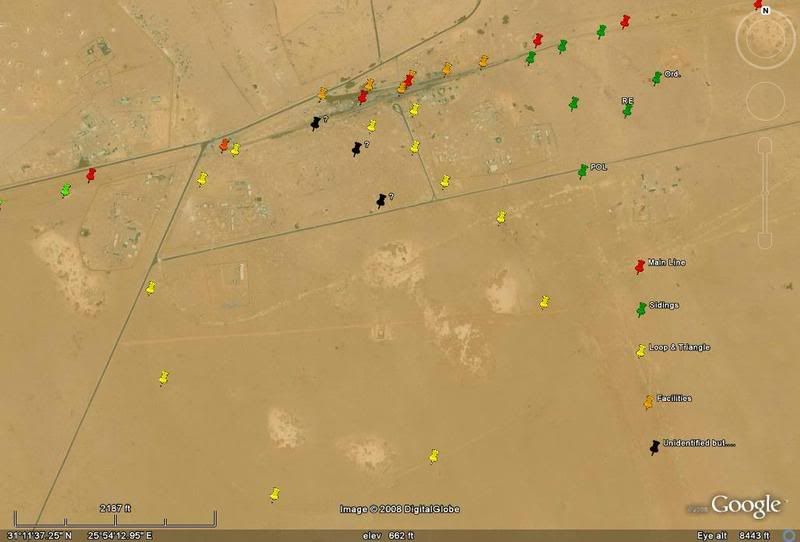
The turning triangle area. The black pins have question marks. I believe they indicate a siding not indicated on the NZ map.
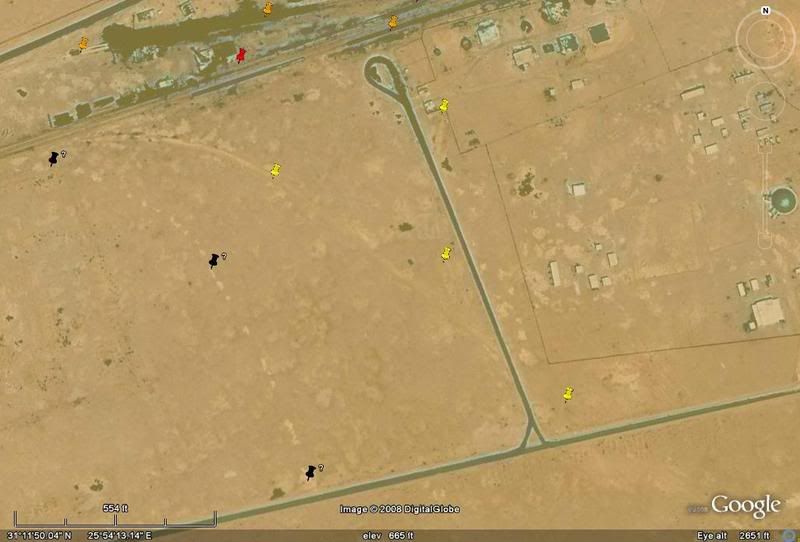
And lastly, the specialized unloading areas at the east end of the complex. Seemingly all that remains is enough of a variation in the surface of the land to create a slightly different microclimate and hence a slightly different pattern of vegetation.
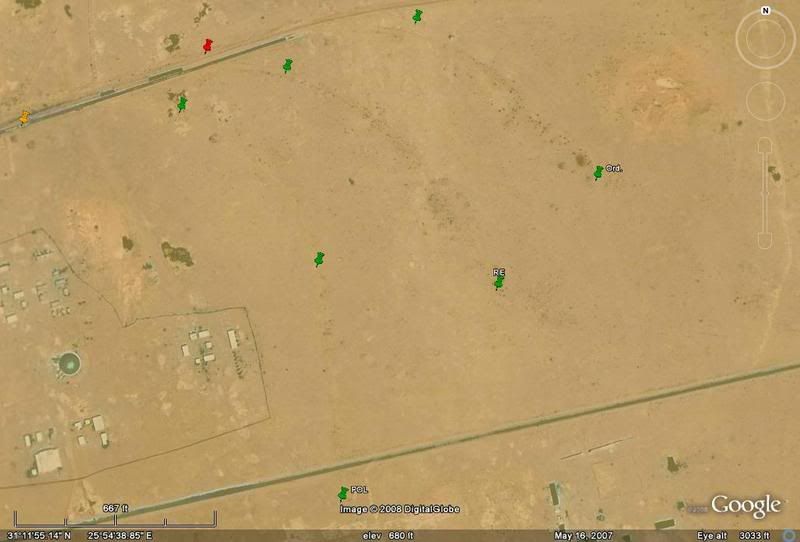

I looked at Misheifa in Google Earth, having apparently too much time on my hands, and identified the main elements of the facility. Although the main line remains most of the rest is gone. It does remain in the form of the roadbed constructed, sometimes merely as variation in vegetation.
First, an overview:

The turning triangle area. The black pins have question marks. I believe they indicate a siding not indicated on the NZ map.

And lastly, the specialized unloading areas at the east end of the complex. Seemingly all that remains is enough of a variation in the surface of the land to create a slightly different microclimate and hence a slightly different pattern of vegetation.

Re: North African railroads
Nice job 
Re: North African railroads
Nice job indeed - and remarkably well-preserved remains, all things considered. The Axis tried expanding the desert railroad both towards Tobruk and SE from Alamein, to which purpose they broke up non-essential track from sidings etc. along the main line. That is, some of the loop sidings at Misheifa depot which still leave visible traces in 2008 may have been broken up as early as 1942. As explained upthread, the balloon layout was a precaution against air attack; at a pinch a balloon loop could also have been used to slow down a runaway train.
Re: North African railroads
Demonstrating once more that I have too much time on my hands (disability sux), in light of the speculation regarding the rail approach to Tobruk harbour I have marked the serpentine path followed down the escarpment.
Some of the former roadbed remains, some has been overtaken by gravel pits, some has been co-opted as roadbed for vehicular traffic, some has blown away but most remains. These are oblique angles in Google Earth oriented from the north.
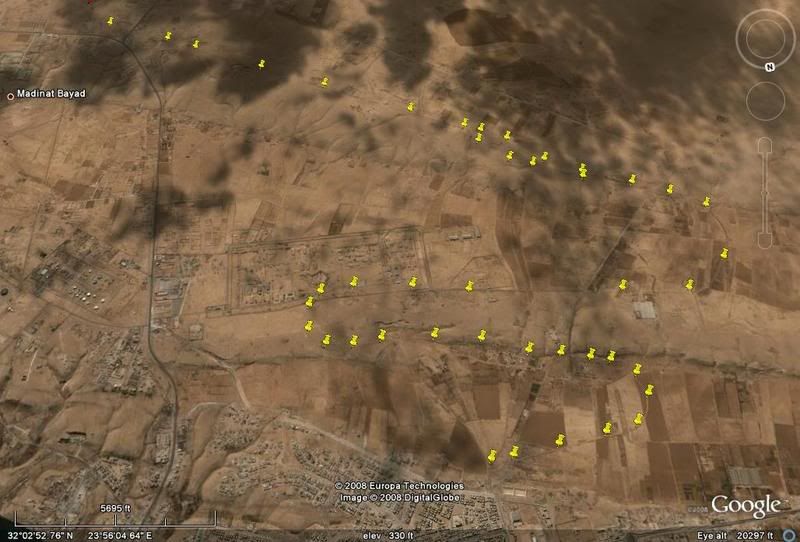
The hard face of the escarpment. Nicely cut.
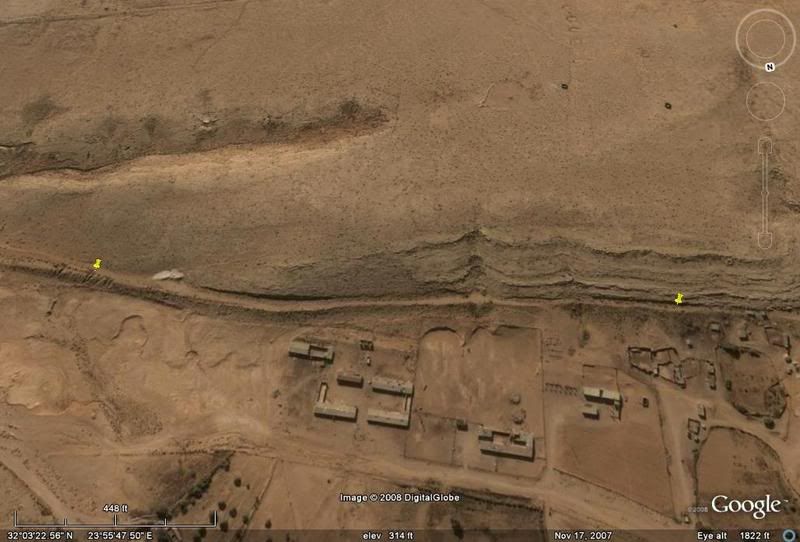
An abandoned bridgework.
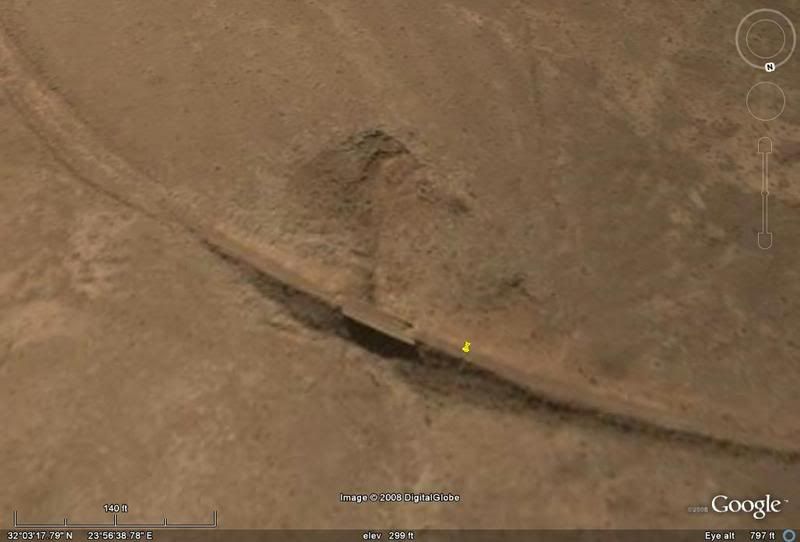
The WWII entrenchments are also well defined as are more recent hull-down tank positions and SAM batteries.
Some of the former roadbed remains, some has been overtaken by gravel pits, some has been co-opted as roadbed for vehicular traffic, some has blown away but most remains. These are oblique angles in Google Earth oriented from the north.

The hard face of the escarpment. Nicely cut.

An abandoned bridgework.

The WWII entrenchments are also well defined as are more recent hull-down tank positions and SAM batteries.
Re: North African railroads
@ sallyg
wonderful job!!!
have you considered doing it for the alamein battlefield?
best regards
Xavier
Der autodidakt
wonderful job!!!
have you considered doing it for the alamein battlefield?
best regards
Xavier
Der autodidakt
Re: North African railroads
Alamein, and most other battles, have been extensively annotated on Google Earth with links to their discussion forum, YouTube , photo galleries and a data dictionary tree now so complicated that it boggles the mind.
It is possible to toggle specific subsets of annotations on and off.
It's a free download and if you are, as I am, visually driven, it is a wonderful tool, although short of a full-featured GIS software package.
It is possible to toggle specific subsets of annotations on and off.
It's a free download and if you are, as I am, visually driven, it is a wonderful tool, although short of a full-featured GIS software package.
Re: North African railroads
Excellent effort, Doug.
While googling around for another choo-choo related topic, I came across the Rail UK page, which has a nice page on the Stanier 8F, the principal engine used on the Western Desert railroad until the US-built Whitcombs came along in 1942.
*Indeed, the NZ railroad troops which ended up building and operating the desert railroad were originally slated for deployment to France.
While googling around for another choo-choo related topic, I came across the Rail UK page, which has a nice page on the Stanier 8F, the principal engine used on the Western Desert railroad until the US-built Whitcombs came along in 1942.
An original order for 240 engines and 10,000 covered wagons was placed by the Ministry of Supply in 1940 for supplying the BEF in France. I don't know if any of the engines were shipped over before the fall of France*, but as we know the machines were used in North Africa and Persia instead....852 locomotives were built to the following requirements:
331 LMS
208 Ministry of Supply (War Department)
245 Railway Executive Committee
68 London & North Eastern Railway
...
Until 1940, relatively small numbers were authorised. This changed dramatically when firstly, the design was adopted for overseas military use in December 1939 and secondly, for quantity production by the wartime Railway Executive Committee.
...
Of the 331 locos built to LMS orders, 51 were requisitioned for military service and prepared as follows:
November 1941 8012-16/18-23/25/28/30-32/38-41/43/45/47/48/86/91/94
December 1941 8024/34/42/44/46/49/51/52/58/59/61/66/68/69/71/72/77-80/85/87/88/93
8F page
*Indeed, the NZ railroad troops which ended up building and operating the desert railroad were originally slated for deployment to France.
Re: North African railroads
Did the British consider switching to diesels for its Middle East lines before WW2?
Re: North African railroads
No, which should be evident from this thread 
The Desert railroad was dependent on Egyptian State Railroad rolling stock, staff and infrastructure, such as coaling and repair facilities etc. It was only once it was decided to expand the railroad west of Smilla that switching to diesels could have been a viable option. Even then, diesels were cutting-edge technology; road types weren't really standard outside of the USA, so it was only once the Whitcomb design mentioned in this thread (AFAIK also selected by the US Army as its standard diesel) became available that changing over from steam became realistic.
For its standard overseas locomotive the War Department chose the above-mentioned Stanier 8F, specifically the simplified 'austerity' version. Not because it was a fantastic engine (it wasn't) but because it was cheap and easy to build (it could be built in comparatively low-tech rail shops without interfering with direct war production) and cheap and easy to maintain.
The Desert railroad was dependent on Egyptian State Railroad rolling stock, staff and infrastructure, such as coaling and repair facilities etc. It was only once it was decided to expand the railroad west of Smilla that switching to diesels could have been a viable option. Even then, diesels were cutting-edge technology; road types weren't really standard outside of the USA, so it was only once the Whitcomb design mentioned in this thread (AFAIK also selected by the US Army as its standard diesel) became available that changing over from steam became realistic.
For its standard overseas locomotive the War Department chose the above-mentioned Stanier 8F, specifically the simplified 'austerity' version. Not because it was a fantastic engine (it wasn't) but because it was cheap and easy to build (it could be built in comparatively low-tech rail shops without interfering with direct war production) and cheap and easy to maintain.
Re: North African railroads
I too am coming to this late having stumbled into your excellent and informative forum while researching railways here in Libya.
I'm a foreign national living and working in Cyrenaica and to pass my spare time have begun to research the local railways.
Here's a photograph of sidi gibrin station, one stop from Barce on the line to Benghazi, taken a couple of weeks ago.
http://www.flickr.com/photos/namestain/5009287072/
if anyone would like me to try and photograph anything or anywhere in this neck of the woods ( within reason of course ) i'd be happy to do my best.
namestain
I'm a foreign national living and working in Cyrenaica and to pass my spare time have begun to research the local railways.
Here's a photograph of sidi gibrin station, one stop from Barce on the line to Benghazi, taken a couple of weeks ago.
http://www.flickr.com/photos/namestain/5009287072/
if anyone would like me to try and photograph anything or anywhere in this neck of the woods ( within reason of course ) i'd be happy to do my best.
namestain
Re: North African railroads
Nice picture, thanks for posting. The Benghazi-Barce line was apparently the last rail line in Libya to be shut down, following the recommendations of a UN commission published in 1951, some time before large scale oil drilling began in Libya - although earlier exploitation of Libyan oil fields probably wouldn't have served the rail network, which in any case wasn't located very close to the oil fields.
If there's anything left of it, and if you find the time, a picture of the Banghazi railroad station as it looks today would be nice to see.
If there's anything left of it, and if you find the time, a picture of the Banghazi railroad station as it looks today would be nice to see.
Re: North African railroads
With that in mind, & considering the shortage of rail, would you care to speculate on the effect of a concentrated attack on rail transport? In particular, bombing railyards? The objective being both to interrupt shipments of components for things like tanks, as well as to disrupt the deliveries of coal, on which German electric power production depended... In collaboration with attacks on river/canal traffic moving coal, forcing it onto rail.Jon G. wrote: As part of the preparations for Husky southern Italy's rail yards had been thoroughly bombed in accordance with Prof. Zuckerman's recommendations, but 'only' 5,000 rail cars had been destroyed out of some 2,000,000 available to the German war effort.
OK, admitting I know even less about this than you do... A quick glance at WP has a calculation for tractive effort, which by my math gives just under 5400 lbf for the Stanier:Jon G. wrote: 2031 hp when the Stanier is running at 20 mph.
t=(cP(dd)s)/D
where
c=0.85 (accounting for operative losses
P=boiler pressure
dd=piston diameter squared
s=piston stroke
D=drive wheel diameter
It also says the record for tractive effort is 199,500 lbf at starting (but the boiler was too small to support speeds over 5mph...), & the Stanier Mogul page has tractive effort of 26,290 lbf. (This evidently means my math is wrong...)
Re: North African railroads
phx1138 wrote:With that in mind, & considering the shortage of rail, would you care to speculate on the effect of a concentrated attack on rail transport? In particular, bombing railyards? The objective being both to interrupt shipments of components for things like tanks, as well as to disrupt the deliveries of coal, on which German electric power production depended... In collaboration with attacks on river/canal traffic moving coal, forcing it onto rail.Jon G. wrote: As part of the preparations for Husky southern Italy's rail yards had been thoroughly bombed in accordance with Prof. Zuckerman's recommendations, but 'only' 5,000 rail cars had been destroyed out of some 2,000,000 available to the German war effort.
OK, admitting I know a great deal less about this than you do... A quick glance at WP has a calculation for tractive effort, which by my math gives just under 5400 lbf for the Stanier:Jon G. wrote: 2031 hp when the Stanier is running at 20 mph.
t=(cP(dd)s)/D
where
c=0.85 (accounting for operative losses
P=boiler pressure
dd=piston diameter squared
s=piston stroke
D=drive wheel diameter
It also says the record for tractive effort is 199,500 lbf at starting (but the boiler was too small to support speeds over 5mph...), & the Stanier Mogul page has tractive effort of 26,290 lbf. (This evidently means my math is wrong...)
Re: North African railroads
But I gave that calculation already, a mere 4½ years ago
http://forum.axishistory.com/viewtopic. ... 36#p884736
There's no need to account for speculative 'operating losses', either. PSI can and probably will vary, but not by a constant 15%. Bore, stroke and driver diameter will remain the same whatever the circumstances.
http://forum.axishistory.com/viewtopic. ... 36#p884736
You don't need the 'c' in your equation when you're dealing with piston psi, as opposed to 'P', 'boiler pressure'The bore (18½") is squared and multiplied with the stroke (28"), which in turn is multiplied by the steam pressure (225 psi). Finally, this figure is divided by the diameter of the Stanier's drivers (56½").
Thus: (18.5x18.5x28x225) divided by 56.5, or 38,162.39 lbs of traction.
There's no need to account for speculative 'operating losses', either. PSI can and probably will vary, but not by a constant 15%. Bore, stroke and driver diameter will remain the same whatever the circumstances.